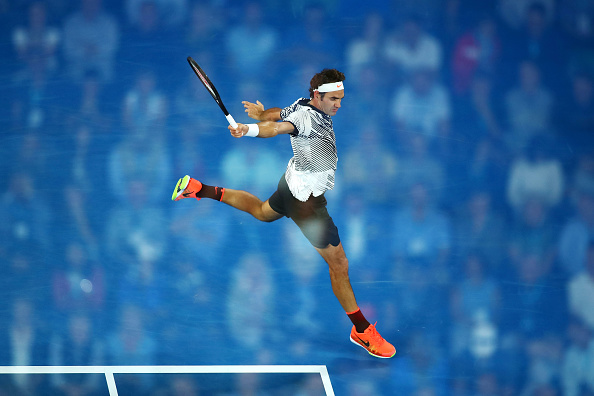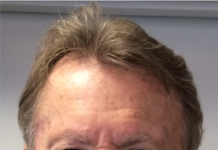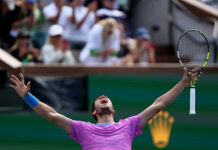Bill Simons
For some, evaluating Roger Federer is simple. Jon Wertheim said, “Roger Federer has the hang of tennis,” But, others tend to get a bit more carried away. For years there was a sign in Wimbledon Village that proclaimed, “And God created Roger Federer.”
Writer Eleanor Preston joked, “Is it possible that Federer is the most perfect tennis player, the most perfect man – in the history of everything, ever?”
To Rod Laver, it was simply unfair: “How come just one man has such an array of wonderful shots?”
We once noted, “His religion is ease. His ethos is, ‘Don’t worry, be Roger.’” Simon Barnes wrote: “When we see genius we recognize and embrace it. It dazzles…[But] there is always a certain elusive quality beyond our grasp…What is a genius and what are their special qualities that uplift us?”
Roger’s signature attributes have long been on display: his sinewy musculature, his fluid backhand, and the every-changing character in his face. But what was the secret sauce of this man who transformed tennis, whom hordes of fans would trek thousands of miles just to see practice, who packed a 55,000-seat South African stadium in a flash and who polls said was more popular than the Queen, the Pope and Obama (but not Mandela)? The chic fashion icon and tireless humanitarian invariably set the perfect tone?
Federer drew on an astounding array of assets. His success was not only built on great technique and mental and physical toughness – his focus was laser sharp. His perspective was profound. His decision making was uncanny.
At 13 he decided, “Forget soccer, school doesn’t have to be at the forefront, I’m going to become a tennis pro.” He announced to his adept parents that he’d be heading off to a Geneva tennis academy – never mind that he didn’t know French and the homesick boy would soon be battling loneliness and sorrow.
In Geneva, the kid would fling his racket, and soon found himself cleaning toilets and cleaning up his act.
Young Roger’s foundational coach, Aussie Peter Carter taught him fabulous technique and became a father figure. But Roger fired him to join up with Swede Peter Lundgren, who knew more about the ATP circuit. Then Carter died in a car crash. Roger was gutted.
Federer did score early wins. But in 2001 he said he was “a ball of stress.” Rackets were flung, tears flowed. When he saw himself on Italian TV he was ashamed. He later told Inside Tennis that if he had continued this way, he’d “go absolutely mental…I realized what I needed to create was fire and ice. Excitement for matches, for points – ice and calm in the right moments.”
He tried to cool it. But he overdid it, and OMG he was too calm. To figure it out, “It took me – I’m not kidding – a year and a half.”
All the while, Roger was flooded with doubt. He finally broke through with his first big win in Hamburg in 2002. But he had problems maintaining his focus week to week.
Then, in 2003, Federer won Wimbledon. But soon, he said, “I was at a crossroads. In 2004, when I became world No. 1 for the first time, I thought, “Okay, do I want to stay there…[and] just enjoy the ride and see how long it lasts before it fizzles out?” I decided I would love to squeeze more of these moments and play the right way with the right mindset and the right flair, but also with fair play and also to represent the game well.”
Roger made incredible decisions. He married his true love, the former WTA player Mirka Vavrinec in 2009, bought a home in Dubai, and, in 2014, switched to a bigger Wilson racket, which helped his backhand enormously. He became a master at scheduling and at times he skipped Miami and the entire clay-court season.
He came to see that being a tennis pro was like running a business, and you were your own CEO. Long comfortable in his own skin, he left IMG to work closely with his adept agent, Tony Godsick, on countless projects – including the Laver Cup, his African school foundation and a lucrative new gear contract. Business schools should study his bounty. The man loves commerce.
Meanwhile, back on court, Roger tried to play with a certain “lightness and freshness.” He observed, “I never panic. That’s the key.” He always looked at the big picture. He won the French Open on his 11th try. In the moment, it was just a matter of, “What can I do in that split-second? …What shot can I hit in that moment and what are the percentages?”
And what were the percentages that tennis would be blessed with a transformative player with all the astonishing shots and skill sets that Roger had? Here are some of them.
*****
BALLETIC BALANCE: Roger Federer is the embodiment of athletic grace. Rarely do we see an odd stretch, let alone a desperate leap. Unlike Nadal, Alcaraz, Connors or Ms. Sharapova, there are few grunts.
Even Roger’s hair-trigger stabs seem soothing. We gasp when he stumbles – he rarely falls. Everything is so refined, so finely calibrated. Yes, he’s a perfectionist, like Fred Astaire. More to the point, Roger seems more like a bounding Mikhail Baryshnikov. Writer David Foster Wallace noted, “Federer is never hurried or off-balance. The approaching ball hangs, for him, a split-second longer than it ought to.” Andy Roddick observed, “Federer has flash, feel, artistry. The advantage I have is just hitting the crap out of the ball.”
PHENOMENAL BACKHAND: Is the Federer backhand, with its stunning fluidity, the most beautiful tennis stroke of the Open era? It’s the shot that has captivated us for decades and packs arenas. Here we see his freedom, his power, his inventiveness, his genius.
Yes, his backhand can be attacked, especially on clay, and he makes occasional mistakes. Early in his career it was erratic, and let’s ignore the fact that he’d never teach his kids a one-handed backhand.
Roger hits his backhand flat, comes up over it with a wicked ease or unleashes a nasty slice. Variety is a constant. His topspin cross-court backhand combines ferocity and beauty like little else in sports. Yet he has a minimalist take on it: “My backhand is there to defend me from tough positions.”
Broadcaster Ted Robinson noted, “In this big booming era, Roger’s backhand slice may be the shot I most remember.” We asked Portland fan Geren Shankar why he’d traveled so far to see Roger play. He replied, “Just his backhand, man. I just want to see it in real life. That thing is phenomenal.”
ZEUS-LIKE FOREHAND: Amidst all his razzle dazzle, at times Roger’s mighty forehand, the gift that kept on giving, was overlooked. It isn’t as fabled as Rafa’s topspin whip, it’s not as big as Juan Martin del Potro’s laser. But it’s powerful and reliable, it has astonishing variety, it’s unpredictability kept you guessing and off balance.
Writer Sarah Kauffman noted, “Roger sends the ball streaming to the opposite baseline like lightning from the fingertips of Zeus. We see the shot and don’t see it at the same time. The conscious mind can’t understand how it happens. But the interplay of his movement and our emotions affects us on a level of pure feeling.” One of our favorite Federer suggestions comes to mind. “It cannot be long before our dictionary writers are asked to absorb the verb ‘to Federer’ meaning ‘to demolish with gasp-inducing precision,’” suggested Sue Mott.
FABULOUS FOOTWORK: We asked Federer what, aside from his mind, is his most important body part. He replied, “Maybe my feet…I have quick feet. I need to be explosive. All anticipation comes through the feet. I worked very hard at it…The feet were something I always felt were really important.”
Writer Christopher Clarey said, “You haven’t lived the 21st-century life fully if you haven’t seen Federer and Nadal play in person.” Staccato steps, quick reverses, flash accelerations, fluid slides – Roger’s footwork is a balletic celebration of muscle memory, anticipation and inspired athleticism. “Federer moves like a whisper,” said Nick Bollettieri. He defies gravity.
LIFE’S A CIRCUS: Roger can grind and get gritty. But he also delights us with fun, OMG circus shots. His creativity inspires. We recall his US Open tweener that stunned Djokovic. YouTube reminds us of the overhead shocker he hit from far off the court off of a Roddick overhead.
STREET-FIGHTING MAN: After a loss to Djokovic, Simon Barnes reflected on Roger’s fierce warrior nature. “The champion of champions, his life now an elegant, elegiac, prolonged farewell tour, was suddenly back in full rampaging force…This wasn’t Federer as the purring effortless winner with that ever-so-slightly smug expression: this was Federer recast as a street fightin’ man.” And Roger always fought the fight. He didn’t once withdraw from any of the 1749 singles and doubles matches he played.
THE SERVE – A LOVELY RHYTHMIC EXPLOSION: Federer’s service motion is not as distinctive as McEnroe’s iconic corkscrew delivery or as flexible as Stefan Edberg’s. He doesn’t unleash a rocket blast like John Isner. Rather, his serve has an economic simplicity and beauty that’s pure Roger.
Like Pete Sampras’s, it’s hard to read – disguise is a weapon. Roger rocks, unwinds and blasts – a quiet, lovely rhythmic explosion, so Federerian. “My serve,” Roger said later, “is about variation and power.”
RETURN OF SERVE: Even more than Nadal’s forehand and Djokovic’s down-the-line backhand, Roger’s slice return of serve has been said to be perhaps the most important stroke of our era. Time and again he blocks back his foe’s serves. Mighty blasts are neutralized with deflating ease – just ask Andy Roddick. Yet Federer told us he was “scared to miss it.” Roger scared? That’s a new one.
VARIETY AND DEFENSE: Anticipation, court savvy, and speed – Roger has virtually every shot in the book. He takes away your time. You have no openings, there’s no Plan B. Andre Agassi observed, “Sampras was great – no question. But there was a place to get to, with Pete. You knew what you had to do…There’s no such place with Roger. He’s the best I’ve played.” Andy Roddick told us, “I’ve never seen anyone who’s been able to take away people’s strengths the way Federer can. He just understands what his opponents do well…I threw the kitchen sink at Roger, but he went to the bathroom and got the tub…He hasn’t missed a ball at a crucial moment for six years against me.”
LASER FOCUS: A-list celebs are in the stands. Bjorn Borg is chatting with Stefan Edberg. Romance is in the air. Fans yell out, “We love you!” or plead, “Will you marry me?” Fans chant “Rah-ger! Rah-ger!” But Roger’s focus is legendary – his precision is Swiss. He’s patient. If there’s no opening, he waits. He works the point, creates his moment, then pounces.
BE HERE NOW: It actually is a compliment when we note that no one in tennis has lost more big matches than Roger. In 20 tourneys he’s had championship points and faltered. He lost to Rafa in the greatest match of all time. In 2008 Novak Djokovic offered a quip that didn’t age well: “I have only three words for Federer: ‘He’s going down.'” The Serb, who has a penchant for saving key match points against Roger, did impose much pain. Often we’d see tears in Federer’s award ceremonies. But no one knew how to compartmentalize, to be in the moment and to move on like Roger. It’s when he loses that he counts on his team the most. It helps to have a family.
LONGEVITY: In 2004 Roger said he was at a crossroads. After losing in Rome in 2007, a reporter asked, “Greetings from Greece. So, is this the beginning of the end for you?” In 2008 the London Times claimed, “Federer in decline is better than practically anyone who has picked up a racket.” That same year a New York writer suggested, “Federer’s ‘08 conquerors now number so many, they almost deserve a T-shirt of their own. Maybe, ‘Honk If You’ve Beaten Roger, Too.’
Of course, his contemporary rivals – Andy Roddick, Marat Safin, Lleyton Hewitt, Jo-Willie Tsonga, Tommy Haas, Robin Sodering – have vanished. A while back, tennis players stepped aside in their late 20s. Sampras assumed Roger would retire in his early 30s. But Roger played on. He loved the arena, the adoration, the competition, and the money. He asked, If you are the best at something, why quit? He had a superb, supportive team and foes who pushed him. He was well aware of (but not obsessed with) the record book.
He told us that as long as he enjoyed the circuit and had the backing of his wife Mirka, he’d battle on.
In 2016 writer Bill Dwyre recalled, “I kept thinking that it’s going to end. I’ve been writing “passing the torch” columns for four or five years now, where I ask will it be Milos Raonic, or Taylor Fritz?
“After a while, I just stopped doing that because this guy is just not going away. …I don’t think he’s normal…he’s now 35 years old and he’s out there flying around. He’s quicker than all the kids, he hits harder, he’s smarter, and when it’s over he looks at the fans and says all the right things.”
WORLD CITIZEN: No ATP player has been so beloved around the globe. The Swiss, who has a South African mother and foundation and has a home in Dubai, has excelled in the US, the home of his agent and many of his suppliers. His wife is of Slovakian heritage and he’s had coaches who were Australian, Swedish, American and Croatian. Roger, who’s played in over 40 countries, told us, “Every continent is unique,” and that he gets a spiritual charge out of being in Africa. Then he says: “I definitely feel like a world citizen, yet I know my roots. They come from Basel – I’m from Switzerland.”
THE ELEGANT GENTLEMAN: Light on his feet, so easy on the eye, ultimately Roger’s an artist. When asked by Tennis Channel to describe himself in a word, he responded, “Elegant.” One observer said Roger “is a classical musician whose symphonies have the power to enrapture us.” Bruce Jenkins suggested, “Federer drifts into an almost dreamlike state, his every shot a casual masterpiece, his every move a beacon of anticipation.”
Eleanor Preston noted, “Federer doesn’t sweat, he glows.” Mary Carillo put it all together, saying, “I’ve never seen anybody make a difficult sport look so beautiful…He knows how luminous he looks…[and] how much he’s pleasing people…He loves being Roger Federer. He knows how many gifts he’s got, and knows how to share them. He bends time. He never seems rushed. It would be hard to cultivate a person who walks so lightly on this earth and with such grace…He approaches incandescence.”




















If only RF hadn’t blown so many break points and match points in slam finals….he’d have 25!! But the most astonishing record: 26 consecutive slam semi finals !